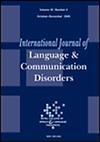Representations of Clients and Speech and Language Therapists in Assessment Reports: A Critical Analysis
Abstract
Background
This paper examines assessment report-writing from a critical perspective, a relatively unexplored aspect of speech and language therapy (SLT) clinical practice. To date, there has been little discussion of the relationship between discourse formats, objectives of assessment reports, and the effects of these objectives on how clients and speech and language therapists (SLTs) are portrayed. Furthermore, there has been little exploration of the concepts of objectivity and scientific writing in relation to report-writing in SLT. An emphasis on a scientific, objectifying system has long been in operation in the profession: the establishment of diagnostic categories and the relegation of the personal, subjective experiences of client and SLT to secondary, non-scientific status. However, person-centred care (PCC) is now a focus in SLT in an attempt to rehumanise care by considering clients as unique individuals with important knowledge to contribute.
Aim
To examine representations of clients and SLTs in assessment report-writing drawing on systemic functional linguistics (SFL) and critical discourse analysis.
Methods and Procedures
A total of 28 assessment reports were collected: 18 assessment report-writing exemplars from published texts aimed at modelling professional report-writing and 10 assessment reports from clinical practice. The global structure of the reports was identified, and the reports were also analysed using transitivity analysis as defined in SFL. Doing, saying, sensing, and being processes, and passives were identified.
Outcomes and Results
Without exception, all reports followed a similar global structure for organising the content, with an overall focus on presenting the speech, language, communication, and swallowing/feeding impairments under consideration while omitting the perspectives of the clients and families. The global structure was characterised by a problem focus. The use of passive verbs masked the SLT as an agent of clinical actions and positioned the clients as recipients of the actions of unidentified professionals while also under-emphasising their individual perspectives, experiences, and goals. SLTs used categorical assertions (i.e., declarative statements with no modality) to make claims appear scientific, while the relatively less-frequent contributions of clients and family members were introduced using saying processes, highlighting their subjectivity. In the paediatric reports, no child's perspective was included.
Conclusions and Implications
Findings reveal an almost exclusive focus on impairment combined with an absence of the client's perspectives, experiences, and goals. Consistent patterns were identified across the data sets. First, verb choices position clients as passive recipients of the actions of the SLT rather than agents in their own right. Second, markers of scientific discourse such as agentless passives remove both the SLT and the client as agents/actors in the SLT assessment process. The findings require us to consider the implications of perpetuating the status quo of report-writing featuring mainly deficit discourse and how we may incorporate PCC in SLT report-writing.
WHAT THIS PAPER ADDS
- A focus on the person in SLT has long been advocated in the literature. The medical model has long been critiqued, and a biopsychosocial model has been promoted. Person-centred care is being implemented in a range of settings globally. Report-writing practices in SLT have not been explored in relation to representations of clients and SLTs at a micro-level.
- This study provides an account of assessment report-writing practices in speech and language therapy (SLT). It highlights the discourses of deficit that permeate the reports through a predominance of patterns which obscure the SLT as an agent of clinical actions, position the client as a recipient of those actions, and omit the personal perspectives of clients and their families. The ‘objective’ is privileged over the subjective, the legal and systemic constraints of the report-writing contexts notwithstanding.
- It can be claimed that in order to successfully argue for services, assessment reports must make a case for client incompetence. This study challenges this claim and provides clinicians with a critical perspective on assessment report-writing practices in SLT. The study also encourages SLTs to consider ways in which report writing may be made more person- and strengths-focused while simultaneously conforming with/to legal and professional requirements.

 求助内容:
求助内容: 应助结果提醒方式:
应助结果提醒方式:


